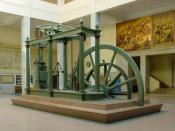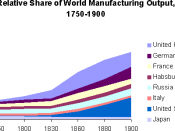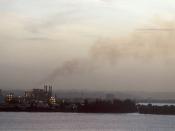Industrial Revolution - fINAL
The Industrial Revolution was a step forward for the world as shown by new advances in technology, new working conditions, and the revolution's profound effect on society. The Industrial Revolution during the 1700's was a time of drastic change and transformation as Western Countries began using machines for mass production. The many advances during this time had mostly positive effects and the Industrial Revolution transformed government, industry, education and man's overall outlook on life.
Many new discoveries, inventions and technology were a direct result of the Industrial Revolution. In the early 1700's, Britain's demand for cotton was high, but production was very low. In 1773, a British weaver named John Kay invented and perfected the flying shuttle, which speeded up the weaving of cloth. The invention of the flying shuttle paved the way for many more inventors. At first, many workers did not use machines for production, but soon factories discovered that these new inventions produced a quality product, faster, cheaper and more efficiently than the previous methods of production.
From new means of production came the development of the factory system and the iron industry. The new machines for production were far too expensive to be owned by the individual worker, so factories, run by waterpower, were established. Factories were built near rivers and brought large numbers of workers together under one roof. With the widespread use of machines in factories, more iron was needed to build them. Impurities found in iron ore mined in Britain caused serious problems in the iron making industry. In the 1780's, a man named Henry Cort invented the puddling furnace. With the puddling furnace, iron was reheated until all of the impurities were burned away. Cort's puddling furnace method produced better quality iron at a speed almost fifteen...



Strait-forward
This is a well-written and very strait-forward essay. Detail included, and accurate facts. Nice Job!
10 out of 10 people found this comment useful.